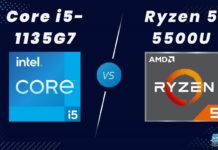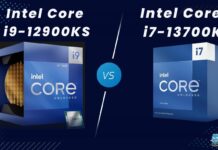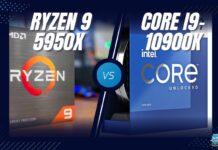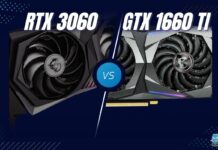Intel’s Hybrid Core architecture did wonders for them as their 12th Gen lineup provided comprehensive performance improvements over the 11th Gen CPUs. In this article, I’ll compare the Core i7-1260P vs Core i7-1255U. The former is rated “P” for power efficiency, while the latter is rated “U” for ultra-power efficiency, and I’ll focus on finding the better one for you.
Key Takeaways
- To start, the Core i7-1260P performed 26.3% better in multi-core applications and was 5.2% faster in single-core applications.
- The Core i7-1260P proved 8.8% more power-consuming under load than the Core i7-1255U.
- Price-wise, the Core i7-1260P laptops range from $681-$4909, while the Core i7-1255U laptops cost between $489 and $4629. Overall, the Core i7-1255U has more value than the Core i7-1260P.
Comparison Table
Let’s compare the specifications of the two CPUs to trace the similarities and differences.
| Mobile CPU | Core i7-1260P | Core i7-1255U |
|---|---|---|
| Architecture | Hybrid Core | Hybrid Core |
| Codename | Alder Lake-P | Alder Lake-U |
| Instruction Set | x86-64 | x86-64 |
| Processing Node | Intel 7 (10nm ESF) | Intel 7 (10nm ESF) |
| Socket |
BGA-1744
|
BGA-1744 |
| No. of Cores | 12 (4P + 8E) | 10 (2P + 8E) |
| No. of Threads | 16 (8 + 8) | 12 (4 + 8) |
| Base Clock |
|
|
| Boost Clock |
|
|
| L1 Cache | 80KB per core | 80KB per core |
| L2 Cache | 1280KB per core | 1280KB per core |
| L3 Cache | 18MB (shared) | 12MB (shared) |
| Memory Support |
|
|
| Memory Size | Up to 64GB | Up to 64GB |
| PCIe Revision | 4.0 | 4.0 |
| No. of PCIe Lanes | 20 | 20 |
| Overclocking Support | No | No |
| Integrated Graphics | Intel Iris Xe G7 Graphics | Intel Iris Xe G7 Graphics |
| GPU Base Clock | 300MHz | 300MHz |
| GPU Boost Clock | 1400MHz | 1250MHz |
| No. of Shaders | 768 | 768 |
| No. of TMUs | 48 | 48 |
| No. of ROPs | 24 | 24 |
| No. of Execution Units | 96 | 96 |
| iGPU Theoretical Performance |
1.69 TFLOPs | 1.69 TFLOPs |
| Total Graphics Power | 15W | 15W |
| CPU Max Operating Temperature | 100°C | 100°C |
| CPU Base Power | 20-28W (configurable) | 12-15W (configurable) |
| CPU Boost Power | 64W | 55W |
| Price Range (July 2023) | $681-$4909 | $489 to $4629 |
| Launch Date | February 23, 2022 | February 23, 2022 |
Also Learn: PC Chipsets Explained
Architectural Differences
- Core/Thread Counts: Starting off, the Core i7-1260P has 12 cores with 4 P-cores and 8 E-cores. The Core i7-1255U halves the number of P-cores, totaling 10 cores. As for the thread counts, the Core i7-1260P has 16 while the Core i7-1255U has 12.
- Clock Speeds: The Core i7-1260P boasts higher base frequencies, with 2.1GHz for the P-cores and 1.5GHz for the E-cores. In contrast, the Core i7-1255U clocks 1.7GHz on the P-cores and 1.2GHz on the E-cores. As for boost frequencies, the Core i7-1255U adds an extra 100MHz to the E-core frequency, equaling 3.5GHz.
- Cache: Although both CPUs have the same L1 and L2 cache per core capacities, the Core i7-1260P has more overall cache (1.1MB L1, 10MB L2). This is because it has two extra cores. As for the L3 cache, the Core i7-1260P has an 18MB pool compared to the 12MB of the Core i7-1255U.
- TDP: The Core i7-1255U is more power-efficient, as evident by the U suffix. It has a configurable base TDP of 12-15 watts compared to 20-28 watts of the Core i7-1260P. Additionally, it can draw up to 55 watts on boost frequencies, while the Core i7-1260P can draw as much as 64 watts.
Similar Article: Core i7-12700H Vs Core i7-1255U
Performance: Core i7-1260P Vs Core i7-1255U
Next, here are the performance benchmarks for the two CPUs.
Cinebench R23

- The Core i7-1260P started proceedings with a win in the Cinebench R23 test. It scored 9746 points compared to 8342 scored by the Core i7-1255U.
- In the single-core test, the Core i7-1260P scored 1745 points, 4.8% ahead of the Intel Core i7-1255U.
Geekbench 5
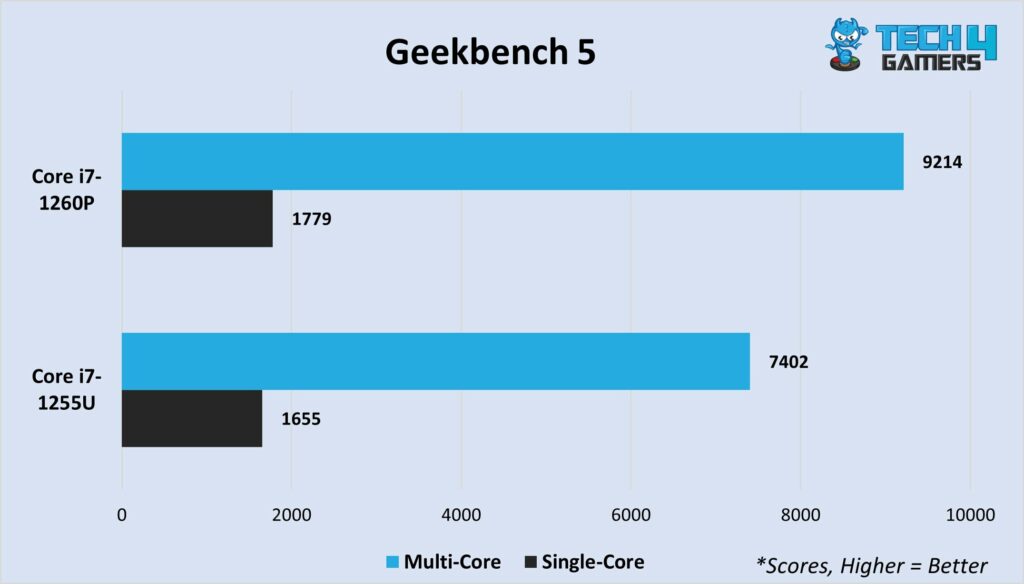
- The next test is Geekbench 5, in which the Core i7-1260P accumulated 9214 multi-core points. In response, the Core i7-1255U scored 7402 points.
- Moving on to the single-core scores, the Core i7-1255U has another narrow win with 1779 points over 1655 points of its rival.
Also Read: HP Envy vs Pavilion
Geekbench 6
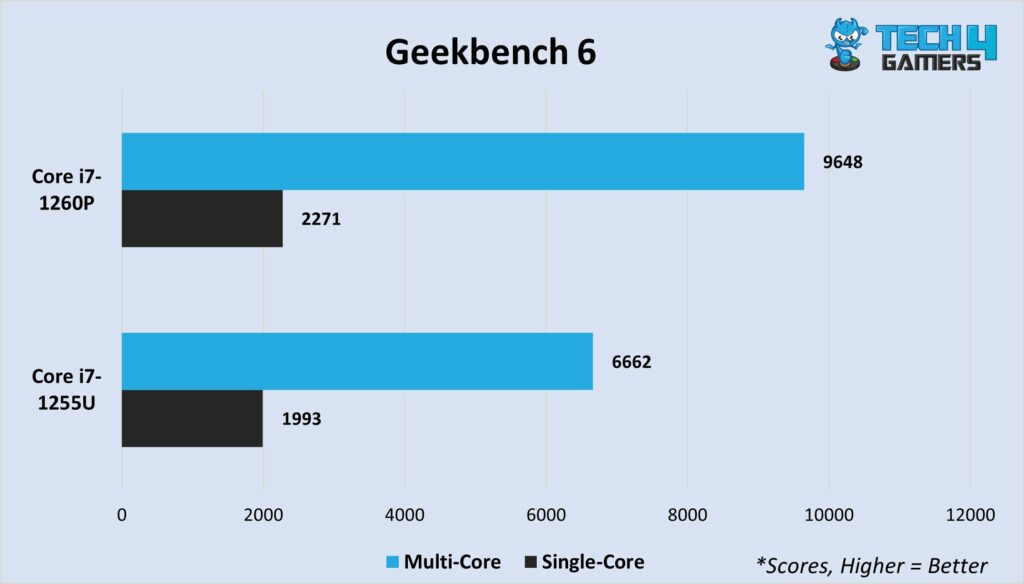
- In Geekbench 6, the Core i7-1260P continues its dominance with 9648 points in the multi-core test. The Intel Core i7-1255U only managed 6662 points, trailing by 44.8%.
- As for the single-core benchmark, the Core i7-1260P recorded 2271 points compared to 1993 of the Core i5-1255U.
Passmark
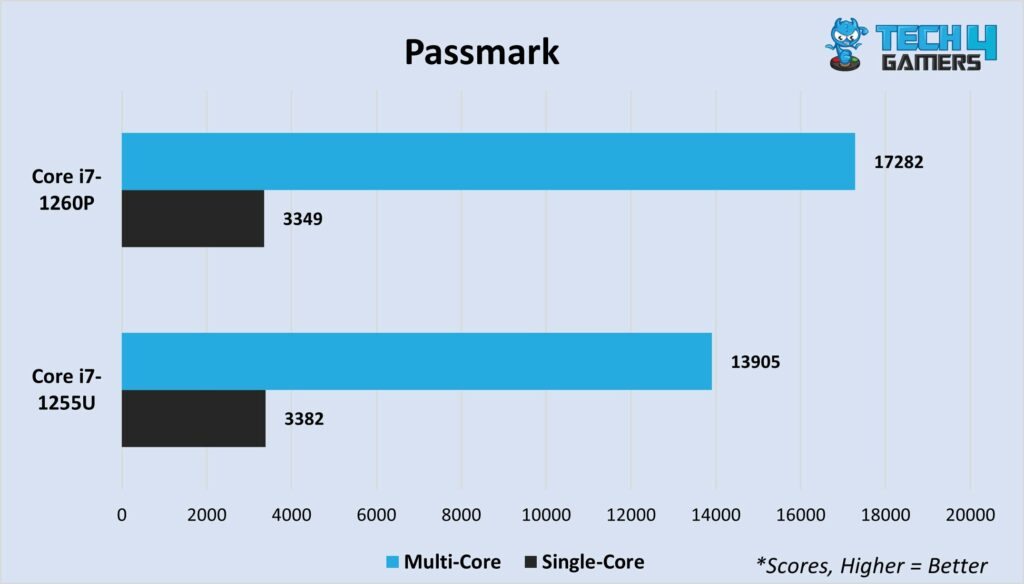
- The next test is Passmark, in which the Core i7-1260P notched up 17282 multi-core points. In comparison, the Core i7-1255U scored 13905 points, 24.2% behind.
- Here, the Core i7-1255U took the lead with 3382 single-core points, leading by nearly 1%.
Another Comparison: Core i7-1255U Vs Core i7-1165G7
Summing Up The Multi-Core And Single-Core Performance
Let’s look at the average multi-core and single-core scores across the four tests.
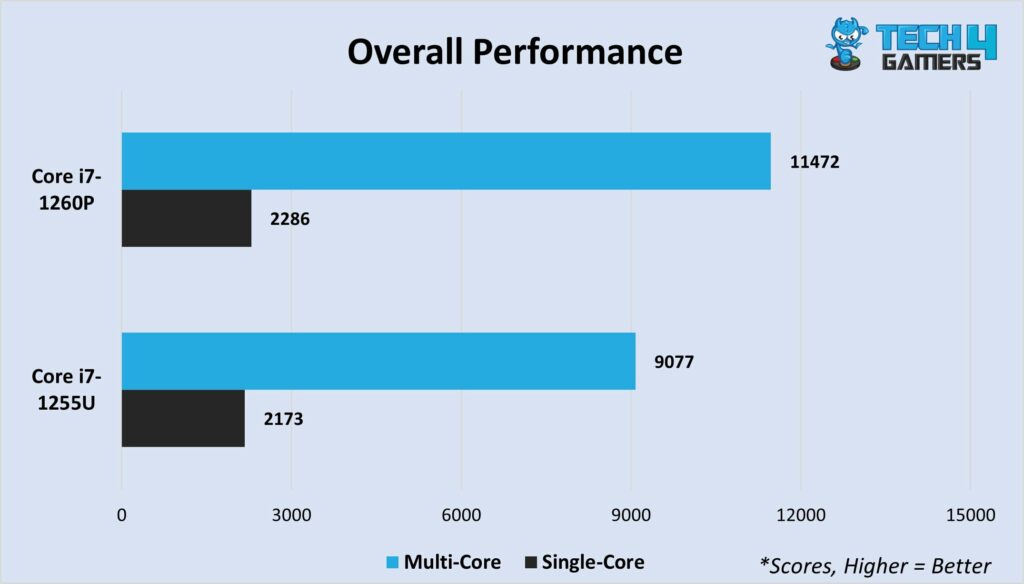
- Multi-core Performance: The Intel Core i7-1260P averaged 11472 points compared to 9077 points across the four tests. Thus, on average, the Core i7-1260P is 26.3% faster in multi-core applications.
- Single-core Performance: In the single-core tests, the Core i7-1260P averaged 2286 points whereas the Core i7-1255U averaged 2173 points. This makes the Core i7-1260P roughly 5.2% faster than the Core i7-1255U in single-core applications.
Learn: How To Benchmark Your Gaming PC/Laptop
Average Power Consumption
Here’s a look at the average power consumption figures at idle and under load.
Reminder: Regarding base TDP, the Core i7-1260P is rated at 20-28 watts, while the Core i7-1255U is rated at 12-15W. As for boost power draw, the Core i7-1260P is rated 64 watts over 55 watts of the Core i7-1255U.
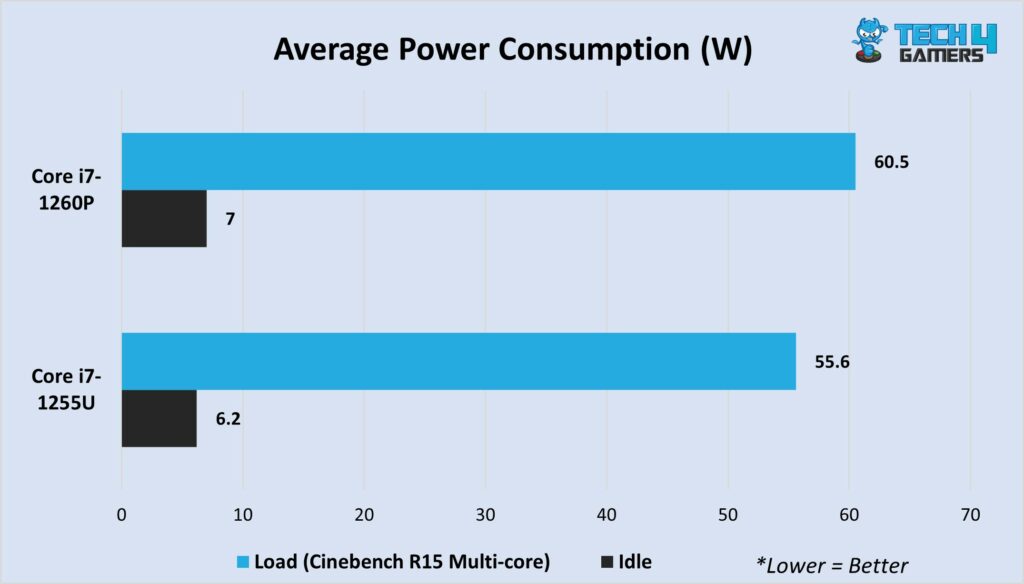
- Idle power consumption: On average, the Core i7-1260P consumed 7 watts while the Intel Core i5-1255U used 6.2 watts.
- Load power consumption: During the Cinebench R15 multi-core stress test, the Core i7-1260P averaged 60.5 watts while the averaged 55.6 watts. So, the Core i7-1255U is approximately 8.8% more power-efficient under loads.
- The Intel Core i7-1255U used 0.6 watts more than it was rated for, while the Core i7-1260P remained under its boost TDP rating.
Read: How To Lower CPU Temperature
Laptop Prices
Next, we’ll go over the laptop prices for the two CPUs.
- Core i7-1260P: Firstly, you can land a Core i7-1260P laptop for as little as $681. If you’re looking for top-selling laptops, your range should be between $824 and $1899. Lastly, if you’re looking for the most premium options, expect to pay up to $4909.
- Core i7-1255U: As for the Core i7-1255U, entry-level laptops start at $489, while the best-sellers are in the $619-$1100 bracket. The most expensive Intel Core i7-1255U laptops can cost a maximum of $4909.
Better Value: Core i7-1255U Vs Core i7-1260P
We can now determine the better value CPU. The Core i7-1260P performed 26.3% faster in multi-core tests and 5.2% in single-core tests. Regarding the price difference, entry-level Core i7-1260P laptops cost 39.2% more than Core i7-1255U laptops. On top of this price difference, the Intel Core i7-1260P consumed 8.8% more power under stress.
As the price difference is bigger than the performance difference, and the Core i7-1260P also consumes more power, we conclude that the Core i7-1255U is the better CPU regarding value.
Also Check: How Much Is My PC Worth?
Final Thoughts
You have reached the end of this Core i7-1260P vs Core i7-1255U comparison. After thoroughly comparing the two CPUs, I’ve found that the Core i7-1260P is better performance-wise. However, the Core i7-1255U unarguably provides better value than the Core i7-1255U.
The Core i7-1260P has two extra P-cores and better clock speeds, giving it better multi-core performance. However, there is little difference between the two CPUs in terms of single-core performance. In the end, the Intel Core i7-1260P costs too much in comparison, making it the unideal choice in this comparison.
I hope this guide has been helpful. Similarly, if you’re looking to build a PC, check out this guide.
Pros And Cons
| CPU | Pros | Cons |
|---|---|---|
| Core i7-1260P |
|
|
| Core i7-1255U |
|
|
Pros And Cons: Core i7-1260P vs Core i7-1255U
Thank you! Please share your positive feedback. 🔋
How could we improve this post? Please Help us. 😔
[Comparisons Expert]
Shehryar Khan, a seasoned PC hardware expert, brings over three years of extensive experience and a deep passion for the world of technology. With a love for building PCs and a genuine enthusiasm for exploring the latest advancements in components, his expertise shines through his work and dedication towards this field. Currently, Shehryar is rocking a custom loop setup for his built.
Get In Touch: shehryar@tech4gamers.com


 Threads
Threads